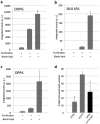Cell-Free Phospholipid Biosynthesis by Gene-Encoded Enzymes Reconstituted in Liposomes
- PMID: 27711229
- PMCID: PMC5053487
- DOI: 10.1371/journal.pone.0163058
Cell-Free Phospholipid Biosynthesis by Gene-Encoded Enzymes Reconstituted in Liposomes
Abstract
The goal of bottom-up synthetic biology culminates in the assembly of an entire cell from separate biological building blocks. One major challenge resides in the in vitro production and implementation of complex genetic and metabolic pathways that can support essential cellular functions. Here, we show that phospholipid biosynthesis, a multiple-step process involved in cell membrane homeostasis, can be reconstituted starting from the genes encoding for all necessary proteins. A total of eight E. coli enzymes for acyl transfer and headgroup modifications were produced in a cell-free gene expression system and were co-translationally reconstituted in liposomes. Acyl-coenzyme A and glycerol-3-phosphate were used as canonical precursors to generate a variety of important bacterial lipids. Moreover, this study demonstrates that two-step acyl transfer can occur from enzymes synthesized inside vesicles. Besides clear implications for growth and potentially division of a synthetic cell, we postulate that gene-based lipid biosynthesis can become instrumental for ex vivo and protein purification-free production of natural and non-natural lipids.
Conflict of interest statement
The authors have declared that no competing interests exist.
Figures






Similar articles
-
A synthetic biology approach to the construction of membrane proteins in semi-synthetic minimal cells.Biochim Biophys Acta. 2009 Feb;1788(2):567-74. doi: 10.1016/j.bbamem.2008.10.017. Epub 2008 Nov 5. Biochim Biophys Acta. 2009. PMID: 19027713
-
Growing Membranes In Vitro by Continuous Phospholipid Biosynthesis from Free Fatty Acids.ACS Synth Biol. 2018 Jan 19;7(1):153-165. doi: 10.1021/acssynbio.7b00265. Epub 2017 Oct 2. ACS Synth Biol. 2018. PMID: 28922922 Free PMC article.
-
Membrane phospholipid synthesis in Escherichia coli. Cloning of a structural gene (plsB) of the sn-glycerol-3-phosphate acyl/transferase.J Biol Chem. 1980 Oct 10;255(19):9413-20. J Biol Chem. 1980. PMID: 6251087
-
Plant sn-Glycerol-3-Phosphate Acyltransferases: Biocatalysts Involved in the Biosynthesis of Intracellular and Extracellular Lipids.Lipids. 2018 May;53(5):469-480. doi: 10.1002/lipd.12049. Epub 2018 Jul 10. Lipids. 2018. PMID: 29989678 Review.
-
[Regulation of the synthesis of phospholipid molecular species in Escherichia coli membranes (author's transl)].Seikagaku. 1977;49(12):1301-15. Seikagaku. 1977. PMID: 342643 Review. Japanese. No abstract available.
Cited by
-
Towards synthetic cells using peptide-based reaction compartments.Nat Commun. 2018 Sep 21;9(1):3862. doi: 10.1038/s41467-018-06379-8. Nat Commun. 2018. PMID: 30242152 Free PMC article.
-
Synthetic Minimal Cell: Self-Reproduction of the Boundary Layer.ACS Omega. 2019 Mar 31;4(3):5293-5303. doi: 10.1021/acsomega.8b02955. Epub 2019 Mar 13. ACS Omega. 2019. PMID: 30949617 Free PMC article.
-
Phospholipid synthesis inside phospholipid membrane vesicles.Commun Biol. 2022 Sep 27;5(1):1016. doi: 10.1038/s42003-022-03999-1. Commun Biol. 2022. PMID: 36167778 Free PMC article.
-
Genetically controlled membrane synthesis in liposomes.Nat Commun. 2020 Aug 28;11(1):4317. doi: 10.1038/s41467-020-17863-5. Nat Commun. 2020. PMID: 32859896 Free PMC article.
-
Shaping Liposomes by Cell-Free Expressed Bacterial Microtubules.ACS Synth Biol. 2021 Oct 15;10(10):2447-2455. doi: 10.1021/acssynbio.1c00278. Epub 2021 Sep 29. ACS Synth Biol. 2021. PMID: 34585918 Free PMC article.
References
MeSH terms
Substances
LinkOut - more resources
Full Text Sources
Other Literature Sources
Molecular Biology Databases

